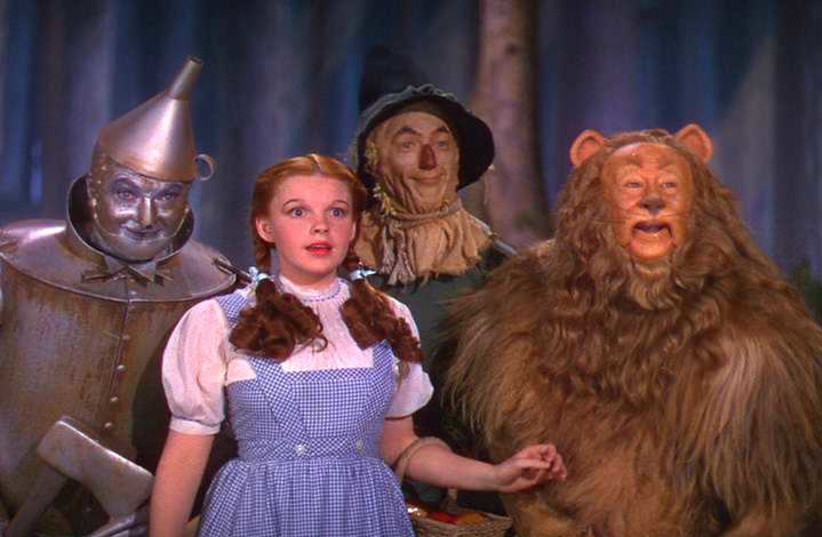Years ago, on a reporting assignment to the Gaza Strip, as we passed through the checkpoint, a fellow journalist’s visibly nervous guest from abroad suddenly exclaimed: “I’ve got a feeling we’re not in Kansas anymore.”
“I’ve got a feeling we’re not in Kansas anymore.”
Dorothy in The Wizard of Oz, also one journalist going to the Gaza Strip
Everyone burst out laughing, as everyone got the reference to Dorothy, the Kansas farm girl swept by a tornado with her dog, Toto, into the fantasy world of Oz. The quote is from the 1939 film The Wizard of Oz, which half the planet has seen.
The theatrical version of that beloved 1939 MGM musical, a close adaptation of the movie by the Royal Shakespeare Company, is this season’s production by the veteran English-language musical theater group the Light Opera Group of the Negev (LOGON).
The stage version includes all the well-known songs from the film, such as “Over the Rainbow,” “We’re Off to See the Wizard,” “Follow the Yellow Brick Road” and “Ding Dong the Witch Is Dead,” as well as songs that were cut from the movie.
All the fanciful and eccentric characters featured in the film appear in the musical: benevolent witches, wicked witches, the Cowardly Lion, Scarecrow and Tin Man and a host of strange beings.

To find her way home, Dorothy and her new friends must journey along the Yellow Brick Road, encountering many dangers along the way, to meet the mysterious and “all-powerful” wizard in Emerald City. In the end, as we all remember, to make it home safely Dorothy must learn that “there’s no place like home.”
“There are many levels to the show. Its greatness is that every age can understand it in their own way.”
Yaacov Amsallem
Several layers of meaning hiding in The Wizard of Oz
The stage show, like the movie, is a family classic. But, like many fairy tales, The Wizard of Oz has several layers of meaning: an adult message wrapped in a fantasy. The original novel, The Wonderful Wizard of Oz, by L. Frank Baum, published in 1900, was both a children’s book and a political allegory about American politics at the dawn of the 20th century. There are many political analyses of the 1939 movie, which appeared against the background of the Great Depression and the Dust Bowl. The film (and the show) can be thought of as a parable of political deceit, of incompetent leaders and their gullible followers.
“There are many levels to the show. Its greatness is that every age can understand it in their own way,” comments LOGON’s longtime stage director Yaacov Amsellem about this updated version of an old favorite.
Nothing in the fantasy of Oz is as it seems. “The Tinman, who says he doesn’t have a heart, is emoting more than any of the characters – he’s crying all the time,” director Amsellem notes. “The Scarecrow, who doesn’t have a brain, is actually the clever one; the Lion, who believes he’s a coward, in the end is not at all cowardly. The man who claims to be a great wizard turns out to be a fast-talking con man. Yet he continues in this role of authority even when he’s been found out.”
IN LOGON’s production of The Wizard, the part of Dorothy (Judy Garland’s famous role in the 1939 movie) is played by 22-year-old New Yorker Aida Hasson, a first-year student in the Medical School for International Health at Ben-Gurion University of the Negev. Aida comes to the show with a background of many years in theater.
Thanks to some spectacular special effects throughout the show, various strange Oz creatures, including the flying monkeys, will also take part in the production.
“Somewhere over the rainbow, way up high, there’s a land that I heard of once in a lullaby....”
The most famous song in The Wizard is “Over the Rainbow,” and it turns out there’s a Jewish angle to this iconic song. The lyrics and music were written by Yip Harburg and Harold Arlen, both sons of Jewish immigrants from Europe who escaped the pogroms of Eastern Europe. That song of poignant longing was written in the 1930s, as persecution of Jews by the Nazis had already escalated.
There was even a third son of Jewish immigrants involved with the writing of “Over the Rainbow” – lyricist Ira Gershwin, who helped polish the melody. He even improvised the coda: “If happy little bluebirds fly beyond the rainbow, why oh why can’t I?”
Writing recently in The Jewish Press, Saul Jay Singer even conceives of a Zionist reference in the song: “It is almost impossible not to imagine that Harburg drew on Zionist movement themes expressing a yearning for Zion.... The Jews of Europe had their own dreams of a ‘land that they heard of’ – i.e., Eretz Yisrael, about which their mothers had sung to them in two thousand years of ‘lullabies’. [But] they were unable to fly ‘over the rainbow’ or go anywhere else....”
LOGON, which draws participants from the south of the country, is the oldest existing English-language community theater group in Israel. Founded in 1981, originally to perform Gilbert and Sullivan operettas, the company now stages a different Broadway musical every year, taking its productions around the country. The Wizard of Oz is LOGON’s 41st production.
Beginning February 23 and throughout March, LOGON will be staging The Wizard of Oz in Eshkol, Ashkelon, Jerusalem, Netanya, Ra’anana, Givatayim, Beit Shemesh, Modi’in, Rehovot and Beersheba. The performances are in English with Hebrew subtitles. For information about performances or tickets, call (08) 641-4081, or go to www.negevlightopera.com or https://www.facebook.com/NegevLightOpera.
